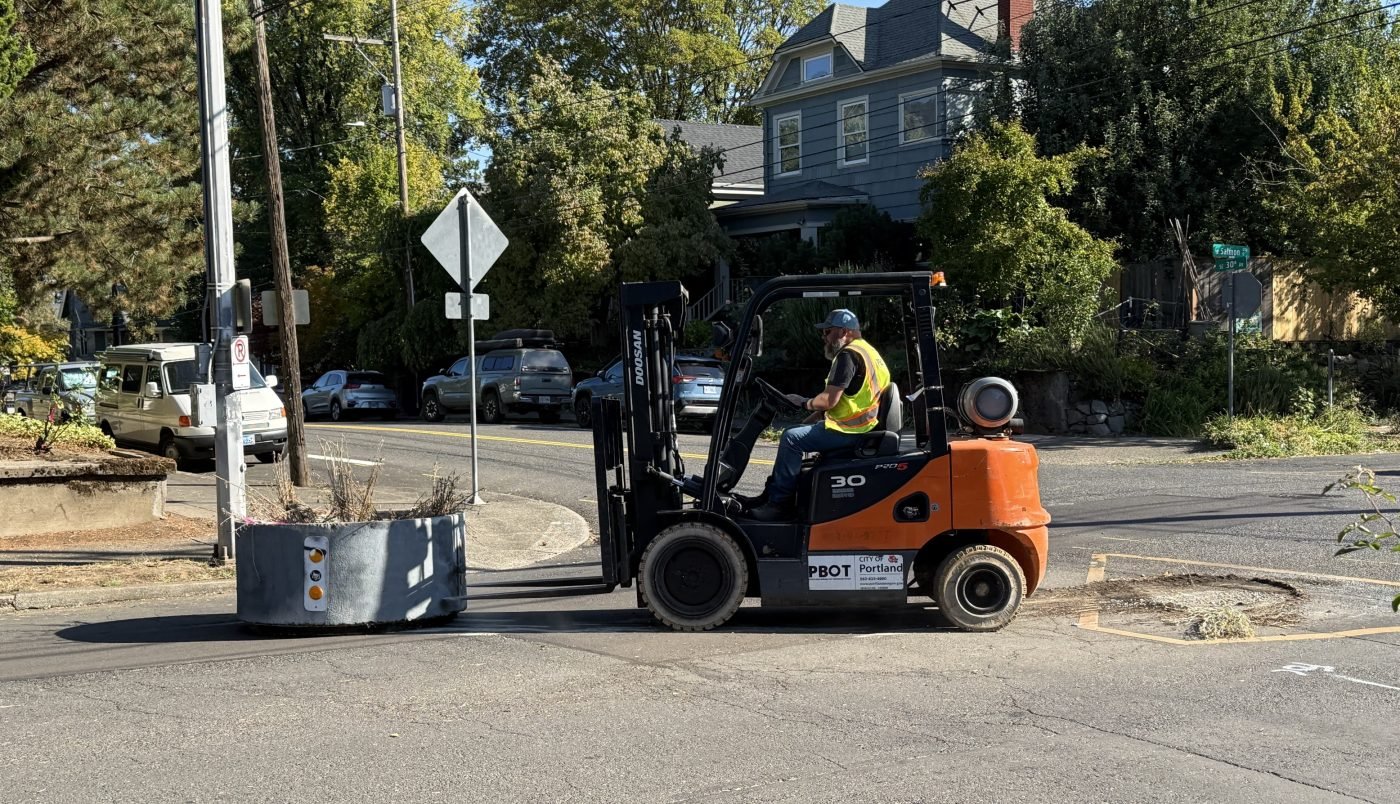
When maintenance crews from the Portland Bureau of Transportation hopped into forklifts and moved the large concrete planters at four intersections along the Southeast Salmon neighborhood greenway earlier this month, I heard about it right away.
Since they were installed four years ago as part of PBOT’s pandemic response to warn drivers they were entering a shared-street environment, these planters acted as 24/7 enforcement against unsafe driving, forcing people in cars to slow down and make safer turns. Not technically diverters, they had the impact of making Salmon much less attractive to car users and therefore a much more pleasant place to bike.
Riders I’ve heard from are frustrated about this on several levels. For some folks, the presence of these planters is the main reason they chose to ride on Salmon. For others, they feel PBOT didn’t warn neighbors or bike advocates about the removal. And given our recent history with diverters, removing important road safety features without proper communication is a very sensitive subject.
There’s some precedent for removing these planters where drivers tend to hit them too often, but this didn’t appear to be the case on Salmon.
One person I heard from shared a letter from PBOT Capital Program Manager Keith Baich that was mailed to residents along the corridor on August 15th. “PBOT will install pedestrian and bike crossing elements to your SE Salmon Street Greenway at intersections with SE 11th Avenue, SE 12th Avenue, and SE 30th Avenue,” read the letter. “This is a scheduled improvement project to support the pedestrian and bicycle networks in SE Portland.”
But there was no mention in the letter that the concrete planters would be removed.
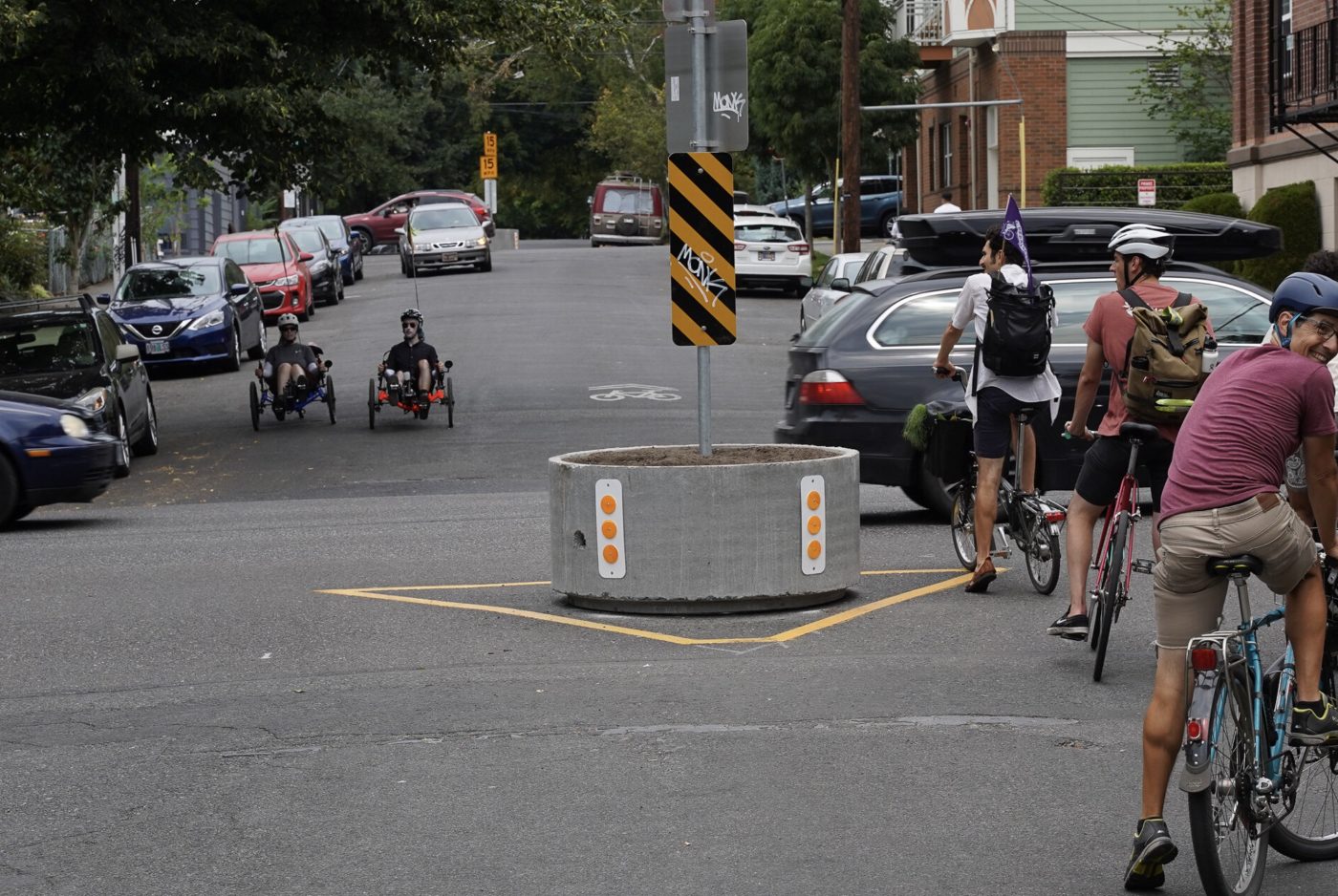
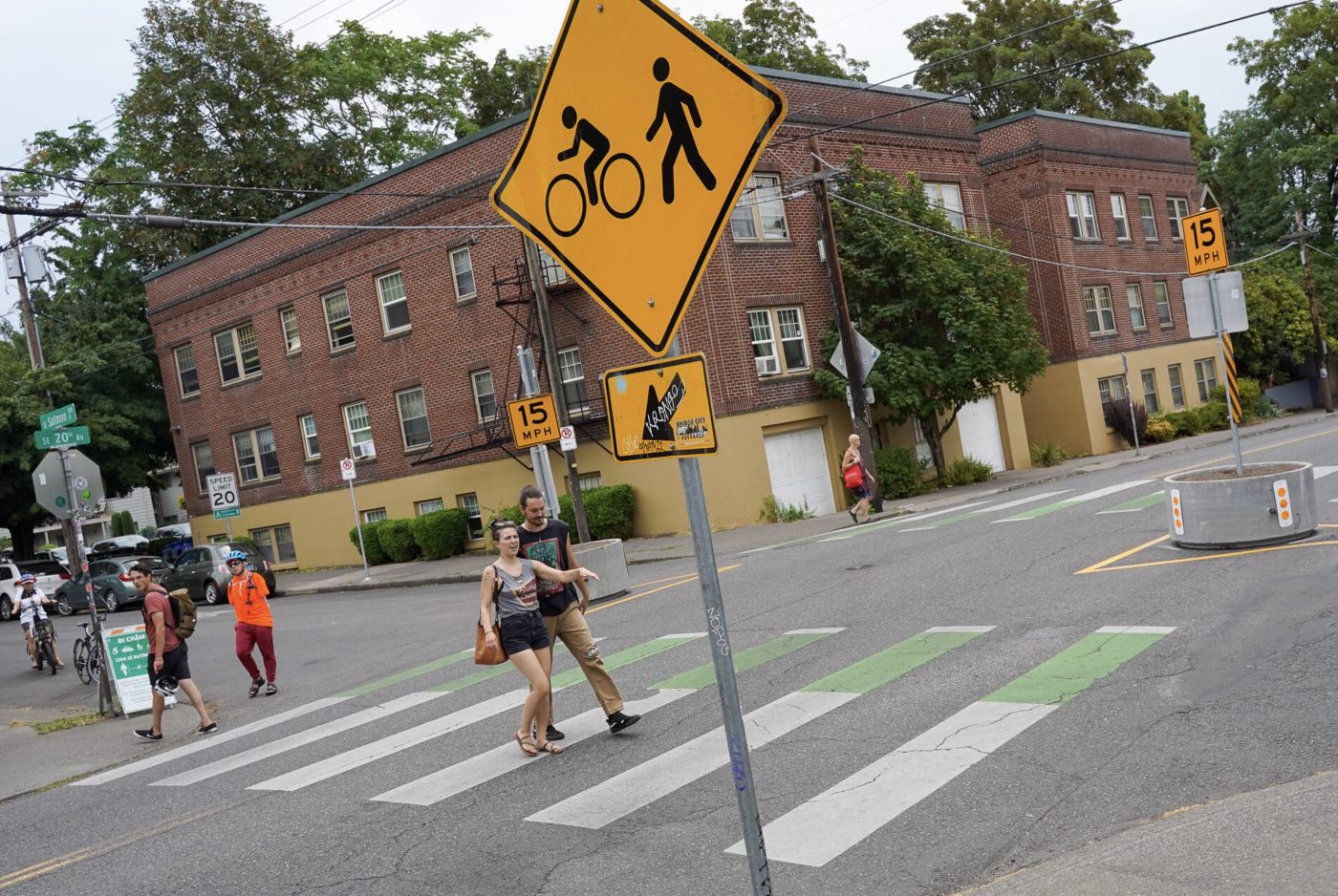
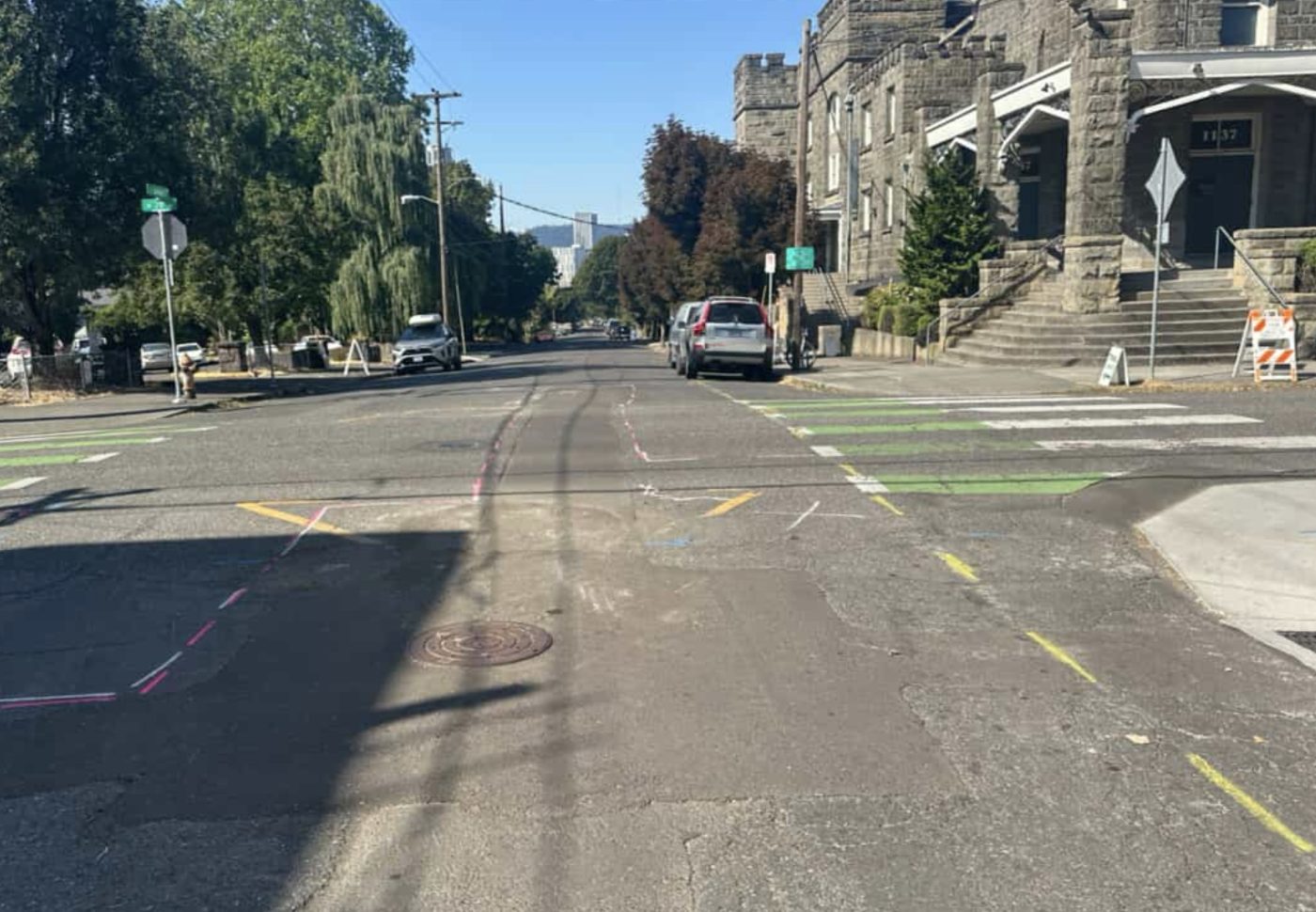
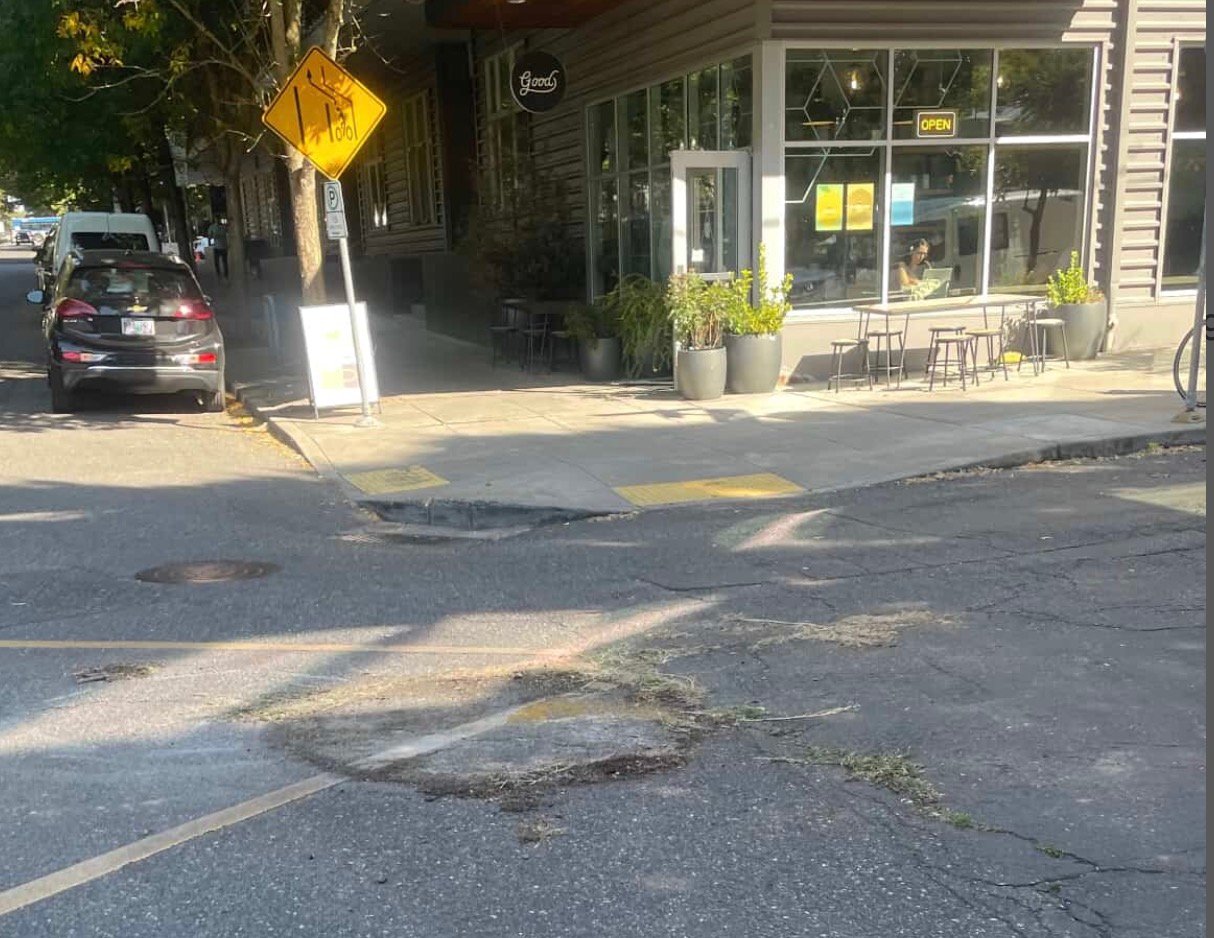
Another person who contacted BikePortland after noticing the removal wrote, “[The planters] really made you feel safer because being at the apex of the hill limited your sight lines looking north. You could tuck in behind the diverter to look down the hill.” Many folks wanted to know exactly what was going on and whether or not the planters would be replaced.
I reached out to PBOT to learn more. Public Information Office Dylan Rivera confirmed with me on Monday that the removals come ahead of a planned construction project that will include “big safety improvements” on Salmon. Here’s more from Rivera:
“The intersections will have more permanent materials that give them a cleaner, more attractive look that will contribute to a feeling of more comfort and safety for people walking, biking or using a mobility device in the area… In their place, we have a contractor preparing to install crosswalks, cross bike markings, parking setbacks, concrete separators, and speed bumps (different treatments at each intersection, depending on engineering analysis).”
Rivera also confirmed that planters have been removed from four intersections: SE 11th, 12th, 20th and 30th. Dylan said the move comes as part of a March 2024 City Traffic Engineer Directive that requires PBOT to replace temporary materials (like these planters, which were ironically considered to be more permanent than the a-frame barricades they replaced) when they require too much maintenance.
Funding for the project comes from the city’s local gas tax-funded Fixing Our Streets program and PBOT expects to begin construction in mid-October.
“We believe the new, permanent materials will be a significant improvement,” Rivera shared.
That all sounds good, but given that the planters are likely to be off the street for at least a month, I’m not sure PBOT fully respects the massive safety impact that comes from stripping a street of its protective barrier while people on bicycles still use it. Would they turn off a traffic signal for a month prior to an electrical upgrade? Or remove lane striping on an arterial before re-striping?
On a thread in the BikeLoud Slack last week, one person posted a photo of planter-less SE Salmon and 30th and wrote, “I almost got hit today by a car turning into me where there used to be a diverter.”
I hope in the future PBOT can find a way to manage a project like this without such a long window of reduced safety before a significant improvement.


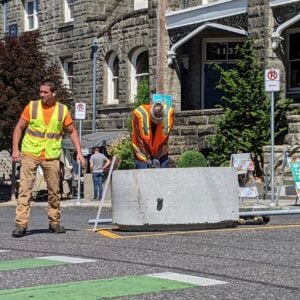


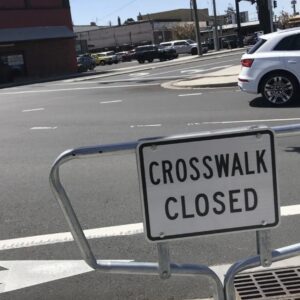
Thanks for reading.
BikePortland has served this community with independent community journalism since 2005. We rely on subscriptions from readers like you to survive. Your financial support is vital in keeping this valuable resource alive and well.
Please subscribe today to strengthen and expand our work.
WTF? I live right at 20th and Salmon and had no idea this was going to happen! Also, there are no plans to replace anything at this intersection. People go way too fast on 20th all the time. What a cruel joke.
The flyer did not mention anything about this being removed, it didn’t even mention 20th. And I have a hard time believing it was too expensive to maintain. I’ve never seen anyone work done on the diverters.
If I knew the fixing our streets gas tax would be removing good infrastructure I rely on with no planned replacement, I probably wouldn’t have voted for it.
They are planning to put in concrete separators, according to Mr. Rivera’s statement. It remains to be seen if they are better or worse. I wish they had some drawings to show what it will look like.
Rivera’s statement is just that the planters are being removed because of the temporary materials directive, and all official communication I’ve seen until reading the project website yesterday was only about 11th/12th/30th. I know I got a flier in the mail that said nothing about 20th. I think that’s a pretty significant oversight, but I also live at 20th and Salmon.
I spoke to PBOT today, “concrete separators” refers to concrete curbs they will put in the bike lane buffer along 12th.
Every time PBOT takes a step forward, they can’t help but take a step back.
The fact that these have planters, which I ride by frequently and have not had problems, are being removed, casts doubt on the legitimacy of this whole “temporary materials” replacement ideology.
Absolutely infuriating that PBOT can’t get the small stuff right.
PBOT’s own evaluation of the Slow Streets planters states that they provide the following benefits, none of which will be provided by new crosswalks, crossbikes, parking setbacks, or speed bumps, which will be provided on the side street (30th) as opposed to on the greenway.
Perhaps the “concrete separators” that Dylan mentions will be used to provide some of those benefits, but it’s unclear what exactly those separators consist of, since they have not been mentioned in any other communication from PBOT on this topic so far.
I’m also curious to know what maintenance has been required on the Salmon planters. Is it just occasional graffiti cleanup? If so, why are we prioritizing some grafitti removal over the safety of people walking and biking?
I’m curious about this “maintenance” issue too. I’d expect crosswalks/bikes to need way more maintenance than the barrels.
I spoke to PBOT today. “Maintenance” is when they need to move the planters back into place. Right now, because of the City Traffic Engineer’s directive on temporary materials, any time a planter is moved out of place, instead of moving it back, they just remove it.
Thanks for this insight to PBOT’s nutty behavior.
Imagine how much signage, traffic control devices, telephone poles, and traffic furniture would be missing if it was removed every time it was damaged when someone operating an automobile collided with one.
The poor (or lack of) communication on the part PBOT seems to be a consistent pattern. The vagueness of the plans for the safety improvements (no timelines, even?) make this much harder to swallow.
What a bunch of garbage!
I don’t share Rivera’s optimism. I think the planters are some of the best traffic calming devices in the city, and I would like to see a lot more of them. My (cynical) prediction: the permanent treatments will be uglier, less adaptable, less effective, and more expensive than the planters that are being replaced. I’m curious whether Rivera really believes the changes will be an improvement and that the user community will generally concur or if they know it’s a crock and are playing coy. The budget expended on this change would have been much better spent deploying more planters.
Micah I cannot agree more. If I were to point to any one policy consistently holding Portland back from increasing modal share it is this: PBoT’s unwillingness to use adaptive, flexible, temporary materials to rapidly expand the separated (low-car traffic) network.
PBoT invariably points to “maintenance” as the reason for this reticence, but if that is the case, why are temporary materials used broadly in other cities around the world? If we are to sit on our hands while waiting for the perfect capital project, when functionally, literal rocks will serve the same purpose, our modal share growth will reflect that. I’d love for Jonathan to do a story on this baffling policy of shooting ourselves in the foot so we can wear prettier shoes.
PBOT used temporary materials and is now coming back to replace them with permanent materials.
It seems like they did exactly what you wanted them to.
Let’s remove the I-5 bridge now since it needs replacement anyway. Seems reasonable according to the execution of this action plan…
This absolutely sucks! I don’t see how the removals help anyone, and as someone who lives near the salmon and 20th intersection, it makes my commuting actively more dangerous.
PBOT: Hmmm. This is soooo hard to figure out. What can we do to make it safer and more inviting to travel by bike. One of the profound mysteries of life. Will we ever find the answer?
Portlanders: Diverters on greenways! Please, Please, Please… more diverters on greenways!!!
PBOT: Jeez. So hard to know. After deep contemplation, maybe we should remove some diverters, or cut down a tree and replace with some little silly thang.
Is anyone keeping a comprehensive list of all the ways/places/instances in which PBOT under Director Millicent Williams has made Portland streets more dangerous for pedestrians and bicyclists? When I made Director Williams sit at the same bus stop where a driver killed Jeanie Diaz, Williams told me she felt unsafe at the intersection as a person outside a motor vehicle. Yet the only changes she had PBOT make at that intersection have made it more dangerous for bicyclists and pedestrians, something I witness and experience regularly. Removing the barriers on the SE Salmon greenway is another example. It’s unconscionable that the director of PBOT’s highest priority is not safety. Nobody should hold that position without safety being the top priority. But Williams was appointed under then-City Councilor Mingus Mapps precisely for her willingness to support his reckless imperatives.
Other cities do this. Portland leaders, please step up.
She’s completely unqualified for the position, and it’s baffling to me that she hasn’t been replaced yet.
It’s possible that Williams had no input into this “minor project” and that this is just another example of PBOT’s SUV-brained engineers and planners prioritizing the bloody car.
Why am I making this point?
Because many cycling enthusiasts cling to the belief that mid-level PBOT employees are their friends despite decades of evidence to the contrary.
COTW
If the leader of an organization sets the policy that, “Safety is our primary responsibility, and all decisions and actions will prioritize safety,” then they do not have to micro manage every “minor project.” And honestly, given the number of humans who bike, walk, and roll down SE Salmon each day, there’s nothing “minor” about endangering their lives.
I suspect you know this but PBOT refers to these kind of projects as “minor projects”. My parenthetical emphasis was completely derogatory.
PBOT actually incurred an additional expense to mobilize a forklift and staff to preemptively remove these planters/diverters and leave the intersection less safe for an intermediate period of time.
A competent project manager would have left them in place and included the service of temporarily relocating as the work required and eventually loading the planters on to PBOT furnished transportation (with equipment the contractor was already mobilizing) in the scope of work. Providing a temporary replacement (like the water filled orange plastic barriers) off hours during the work should also be a contact requirement..
I noticed the planter at NE 92nd and Tillamook has been quietly removed as well. Anyone have info on this?
That one was part of the purge they started last year because drivers kept hitting it. It’s even in Jonathan’s story about the decision to remove them pushed several feet out of place.
NE 92nd and Tillamook is listed on the PBOT project page linked in the article as part of this same greenways project. “Concept design in progress;” construction in Spring/Summer 2026.
I’m not down on everything PBOT does but sometimes I think their decisions are made by people who have never actually visited or used the sites they change. Like, maybe they look at the overhead Google map and say, “Hmm, this should work.”
I think it’s kind of corny that they took the planters away so long before putting in permanent infra. Other than that, it’s fine I guess. I’m interested to see what it looks like when construction is done.
The planters worked! They kept me and my family safe. Now I feel unsafe. Thanks PBOT.
Apparently, it only took part of a day to remove them. If that’s the case, why not wait until AFTER the new “improvements” are installed to yank critical safety infrastructure from our streets?
It took years of advocacy to get the planters installed in the first place. Now they are removed with zero community outreach or consultation. What a slap in the face.
The removal got about as much community input as the original installation did.
I bike on this street every day, often with my children. Taking away infrastructure that slows cars down seems like a step backwards. It’s frustrating because previously those planters were referred to as “permanent” in a lot of PBOT press releases and other materials.
I do look forward to the other safety infrastructure that is slated for the street, including crosswalks and speed bumps- those are much needed and will be great. But I think that hard infrastructure is important too. I am glad that Dylan Rivera mentions concrete separators (though I’m not sure exactly what those look like). I hope we can get the planters back, or other hard concrete infrastructure that makes the greenway a less convenient choice for cars.
I live there and got no notice. Though I was hoping the removal meant they are installing something new and possibly better.
Who do we contact to request actual diverters at those intersections? Especially at 30th, I’d like to see turns no turns onto Salmon. So many drivers use the 30th (or 27th) to 20th stretch to avoid Hawthorne or Belmont, and they BOMB down the Salmon hills in both directions.
It is kind of crazy that the Salmon greenway has no diversion from Cesar Chavez all the way 7th, almost 2 miles. Especially lame because drivers have Hawthorne, Belmont, and Stark to use.
It is a greenway in name only, like almost all of PBOT’s “greenways”. This is bikewashing- used by PBOT market the City as bike friendly without doing anything meaningful to create a functional network or protect cyclists. PBOT loves to talk about miles of greenway, but the greenways have no diverters, they have terrible routing, they are disconnected and disjointed- it is a sham.
Yeah, some diverters on Salmon seem like a no-brainer. It’s pretty well-used as far as bike routes go, and there’s tons of parallel streets for car access. I’d love a few diverters and smoother pavement on Salmon.
In this day and age, why can’t pbot publicize their actions or planned actions on their own website or the socials or even letters to owners in the block? Why is it they have be chased down time and time again by bikeportland?
Insane.
Such “transparency”
Those planters acted as diverters for about two trips per driver, after which those drivers learned that they needn’t change their regular routes. The planters DID provide something large, heavy and rough enough to damage any painted vehicle that hit or even sideswiped one.
They never made me feel safe, but I now realize how much more exposed I feel when I can’t keep a planter between me and incoming traffic. I cross 20th twice a day, every weekday, and if they’re not planning on replacing those two with something better, they’d better put the planters back.
I bike this street every day. Just yesterday there was a car crash at 30th and Salmon. Before the removals, I had never seen one there before. Only took about a week after the removal for it to happen.
The article just posted here on BP regarding the driver blasting over a curb, across a MUP and into a MAX track really highlights why concrete barriers are needed wherever feasible. The timing of these two articles seems darkly delicious.
PBOT consistently lies. They are intentionally misleading about “bike improvements’ and Pedestrian safety measures” which are actually installed to make it easier and faster to drive a car. It has been many years since PBOT acted as a good faith steward of the bike and ped network. Ignore the spin from Rivera and just look at what they do.
Also removed at 16th and Belmont as well as 16th and Morrison
Is this more backsliding on bike infrastructure, or just poor communication? Is PBOT making decisions with dice rolls? After a few rounds of this they should have a “talk to the community” lane on their game board.
I honestly feel like Portland has been regressing a lot lately with regards to our progressive transportation infrastructure. Being a cyclist in Portland makes you feel significantly more marginalized than it did just a few years ago; I’d really like to see an article that investigates whats changed in our city government’s policy about non-car-centric streets.
It’s pretty clear what’s changed — since 2015 or so, lots of people stopped riding. That loss of ridership inevitably led to a loss of prioritization and political power, and while PBOT still has some pro-bike inertia, we’re starting to see it slow down.
I think it’s that simple.
Bike mode share is ~3%.
I dont get it. Why wouldnt they just remove the planters when they are going to make the upgrades? Someone explain this to me like I’m dumb.
Maybe you’ve got one team that drives the forklifts and stores things and another that builds stuff, and you task each team independently, and it’s important that the forklift guys show up before the building guys, so you allow some buffer in the schedule to allow for real life, and this is how it plays out.
That’s generally how large organizations do things.
Have you paid any attention to road construction equipment in the last few decades? Even if this is a project being self-performed by PBOT and not contractor the equipment involved is extremely likely to include a backhoe, skid steer or front end loader that can quickly exchange the bucket for pallet forks. Any excavator involved can also act as a crane for a load of this size.
This is simply an example of PBOT not prioritizing safety over convenience and also likely unnecessarily incurring additional expenses.
Why do you think PBOT is sending the same team out twice to do work that could be done in one visit? Too little work to keep themselves busy?
Why don’t they leave the planters even after they put in the speed bumps and other ‘big safety improvements’?
Jonathan,
It seems like you want a government that runs like a Swiss watch—efficient, responsive, all gears turning. But then you support city councilors and Multnomah County leaders who think running a city and County means issuing Gaza statements, hating on the police, renaming bike lanes, and holding equity vision quests. Can’t have it both ways, mate.
lol this is 10/10 troll bait. Can you link to BP articles where Jonathan has endorsed any of that “woke garbage” you listed?
Righto mate — here’s a quick list of who Jonathan tends to give positive coverage to:
Jo Ann Hardesty
Chloe Eudaly
Jessica Vega Pederson
Keith Wilson (Mayor)
Mitch Green (City Councilor)
Candace Avalos (City Councilor)
Angelita Morillo (City Councilor)
These are the folks frequently pushing exactly the kind of “woke garbage” you mention — Gaza statements, anti-police stances, endless equity task forces, obsession with Donald Trump and more time visioning than doing.
So yeah — Jonathan doesn’t always say “I endorse X,” but if you read BikePortland, it’s pretty clear who’s getting the praise and platform.
Ok but can you link to one article to substantiate your claim please?
Reality-based speech (or thought) is antifa terrorism.
Another step backwards.
here’s my observation: when the concrete barrels went in, the response on BikePortland was largely “meh, can’t PBoT do something useful?”. Now, it seems, people have become very attached to them. Ah, the vagaries of public opinion..!
This comment matches my perception. I think there is a reticence to publicly admit the utility or usefulness of changes made by PBOT out of fear that such comments will detract from the urgency of getting more improvements or fail to sufficiently acknowledge the challenges and risks of biking in PDX. An example that sticks in my head is the severe criticisms of the Greeley path that appear in the BP comments (you might have to wait for the light at Going, cars sometimes park at Hazelnut Grove, etc.). These are valid points, but I feel like they miss a bigger picture.
Micah,
I am interested in your understanding of the bigger picture of the Greeley Bike lanes. I have been commuting to the central city from north Portland by bike daily since 2008, and there was significant drop-off in bikes using Greely after the change. In addition to the cars on the path, the connection to eastbound Going is terrible, and the connection to Interstate is bad. Since this is in my neighborhood, I was able to have a conversation with the PBOT project manager and her supervisor and the EOR. There was consensus that the connection was substandard and inadequate, but they felt was outside of the scope. They also explained they could not address driving speeds because this was a “freight” project and Vision Zero/safety concerns were not part of the program (despite 2 young girls being killed by being rear-ended here during the design process!).
To my understanding, this is the bigger picture:
I’m curious about your comment that ridership fell after the Greely project was completed. I don’t ride up that way very often, but I did both before and after the project. Before, it was tough going — I felt you could ride it safely, but needed nerves of steel. After, it was safer (probably) and less nerve wracking, but also a bit more confusing and a bit slower.
All-in-all I thought it kind of sucked before, and kind of sucked afterward, but in a different way.
So… Do you share my assessment, and why do you think ridership fell in that spot (and was it site-specific, or could it be attributed to the general decline in biking everywhere in Portland)?
My typical commute is down interstate in the morning. Before the change, there was a or cyclists going down Greeley. The old route kept them in the roadway, and most cyclists would run the red light and merge into the bike lane on Interstate. This is at the bottom of the hill for both routes, so it was something that happened regularly and I was on the look out for- not a problem if you noticed a bike coming in hot. It was not uncommon for 3 or 4 bikes to show up all at once, and since I was going fast (bottom of the Interstate Hill) I would use the car lane to pass if it was available.
After the change, the number of cyclist has dropped off to tiny trickle- maybe one a week instead of multiple bike per day. I know it is just anecdotal, and that bike usage has dropped off city-wide. This path was pitched to the neighborhood as biking/walking path (despite being painted as 2-lane bike path and not being wide enough), and I think if it was designed well, it could have seen a lot of use from cyclists and joggers and maybe a few dogwalkers. As it is, it is almost always empty.
I think I do share your assessment that the bike route was fast and direct but unnerving/unsafe (because of highspeed traffic and crossing an offramp) before, and it is safer along Greeley after the change, but less efficient ,and now has unnerving/unsafe crossings at Greeley built in and some uncomfortable stretches past Hazelnut Grove (barking dogs, vehicles on the path) and an awkward connection at Interstate. They traded in one set of unsafe/unnerving conditions for another, but they sacrificed the speed and efficiency of the bike route.
Hi maxD! Thanks for your reply. My short version of the big picture on Greeley is that it used to be a car only highway and now it has a visible and (well) protected bike path.
For two years in the late 90s I commuted from Arbor Lodge to downtown using Denver and Interstate to the Broadway Br. I lived away from Portland for a long time. Now that I’ve moved back I ride Greeley a couple times per week (I live a bit further east). BITD, I didn’t consider it as a reasonable route, but now I go out of my way because it is a nice ride. Everything you say about the path seems reasonable to me (expect maybe complaints about cars on the path), but, still, I think what we have now is so much better than what existed before.
Let me respond to your criticisms of the Greeley bike path.
Cars on the path: I don’t believe this is really an impediment to biking the path. I’m sorry, that just does not seem like a reasonable argument. In the rare cases when there is actually a car on the path, there is plenty of room to get around the cars.
Connection to eastbound Going: I agree this is bad, but there is almost no destination for which the best bike route uses that connection, and you can just use the left turn lane if it’s really that hard to use the ped crossing. Or cross at Adidas. Or take Denver. That’s not a defense of the poor design, but I don’t think it detracts much from the project.
Connection to Interstate: I didn’t really understand what you were talking about until I read your reply to 2wheels above (that you prefer to be able to make the (illegal) turn on the red light from Greeley onto southbound Interstate). That’s something I can at least understand, but I would much prefer to not have to cross the i5 onramp just before that light, so I vastly prefer the current configuration. I wholeheartedly agree that the northbound Interstate –> Greeley connection is bogus and think there should be changes made to show bikers how to use the left turn lane to access the Greeley path when travelling north on interstate under the Fremont Br.
Cheers,
Micah
Micah,
Thanks for the reply, and I can totally see where you are coming from. The old bike lane was unprotected. Even though it was very fast and direct, crossing the on-ramp was harrowing. The new design is distinctly more pleasant and safer to ride on, and you feel the trade-offs (crossing Greely, poor connections, etc) are minor and mostly acceptable. I appreciate that perspective and thank you for sharing it. I do not fully agree, I think the deficiencies are enough to have turned many riders off of using this route.
I spend a lot of time (personally and professionally) thinking about public spaces and bike/ped routes are a part of that. What frustrates me about Greeley is significant amount of cost and effort that went into it, but the dearth of care that went into the planning and design. The section from Interstate to Going went in just after the section from Going to Killingsworth, and they are clearly each designed in a vacuum. Bikes are callously shunted from one side of the street to the other to work around infrastructure, and the connections are tenuous at best. PBOT knew about these deficiencies, but it was too late because PBOT simply does not value or prioritize the bike network. I appreciate PBOT’s effort to get the most out their projects to cobble together bike routes, but it is not good enough. We need some visionary planning to identify routes, and some conviction to work the details to provide simple, safe direct routes that well-connected to one another. All of the biking/walking routes from North Portland funnel down to Greeley and eventually the incomplete sidewalks and narrow bike lanes on Interstate Avenue. It so lame and substandard, but PBOT just focuses on the little tiny protected part and claims to be doing good job.
Thanks for the discussion. You’ve given me some things to think about.
you too!
Nah…the response was that these are great but that PBOT was putting them in the wrong part of the roadway.
well apparently they’re in the right part of the roadway now…
I’d love to see the mailing list the notice was sent to. We are one block off the corridor and received zero communication about this.
I’d guess it was to everyone with a Salmon St address, maybe corner properties with a side street address?
My Mom lives in a residential memory care facility on Salmon Street and she loves seeing the bikes and pedestrians and dogs that go by. Sometimes she says she saw me bike by, even though I am come from the opposite side of the building. It will be a shame for her and the other residents if people are dissuaded from using Salmon as frequently.
My office is at the corner of SE 11th and SE Main. Several times a week I’m startled by high speed traffic and honking because of cars on SE Main trying to cross SE 11th. I think that whole section of SE 11th from Belmont to Madison needs to slow down. I’m hopeful that the switch from to a more permanent crosswalk will help to slow down traffic on SE 11th and make that whole corridor safer, for bikers (I bike there every day), pedestrians (I walk that neighborhood several times a week) and drivers (I don’t want anyone to get into an accident!) Over the summer I saw a man grab his young daughter as they crossed at the crosswalk up by Roselone/Kachka. I hope PBOT will consider other solutions like speed cushions as well.